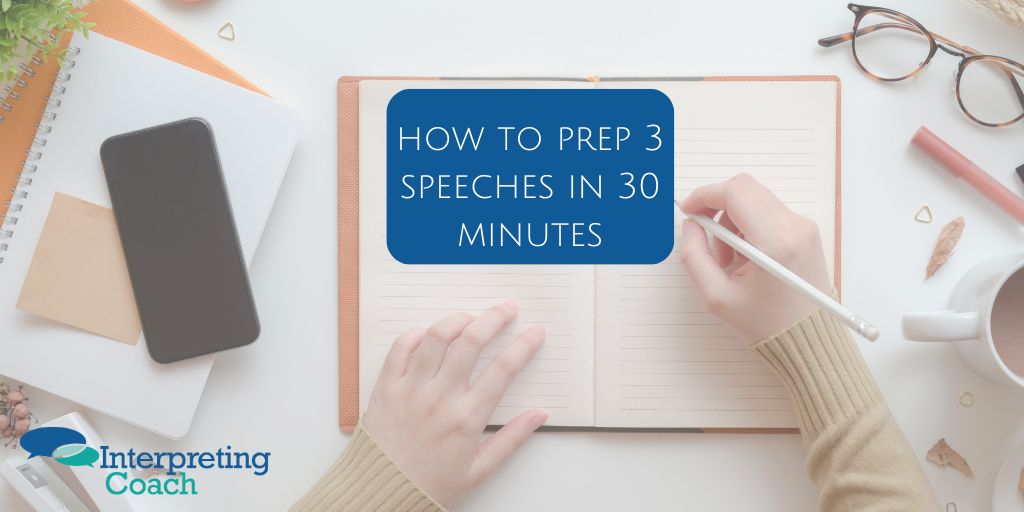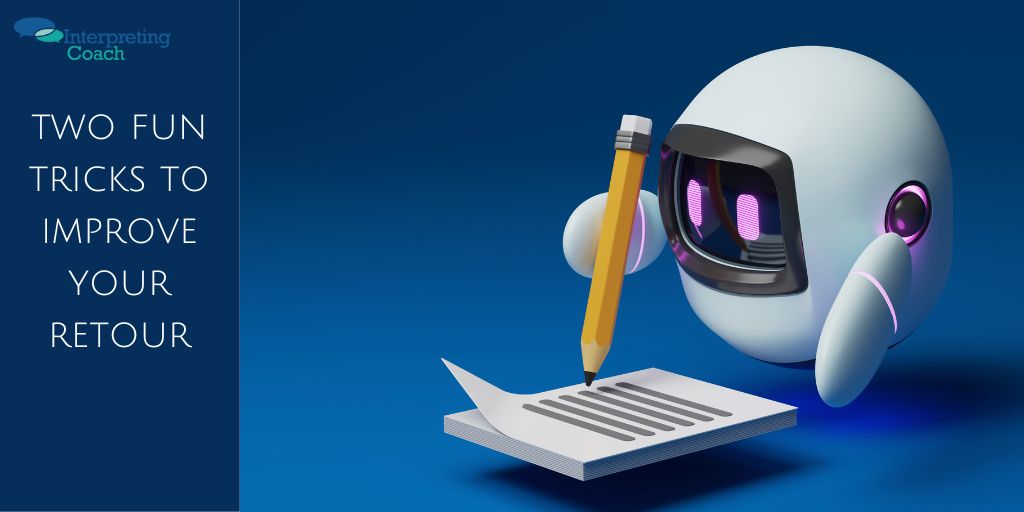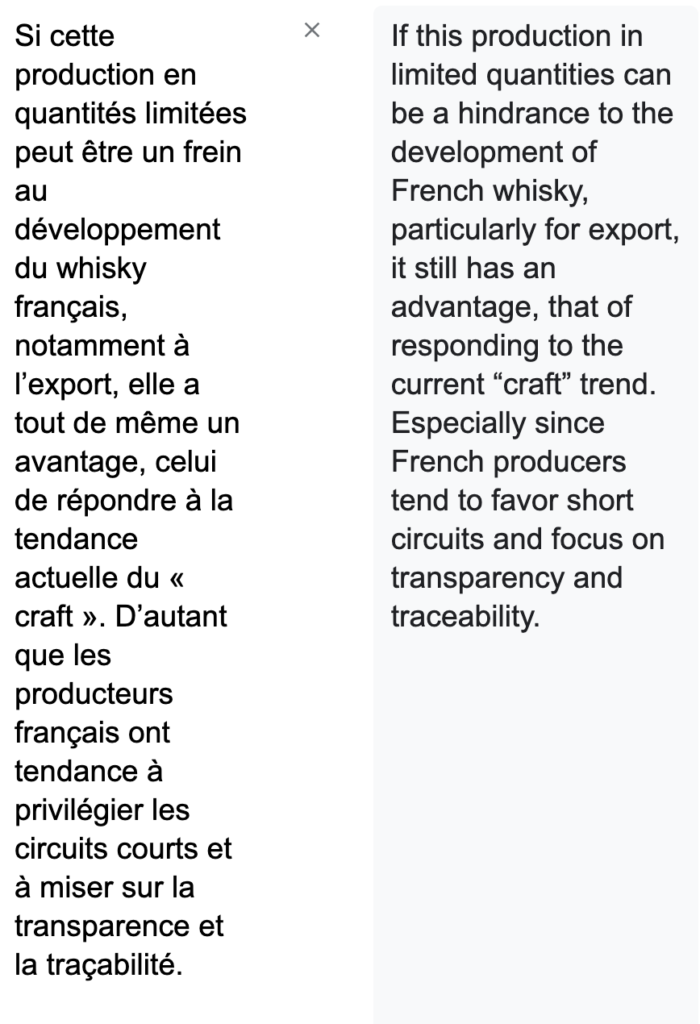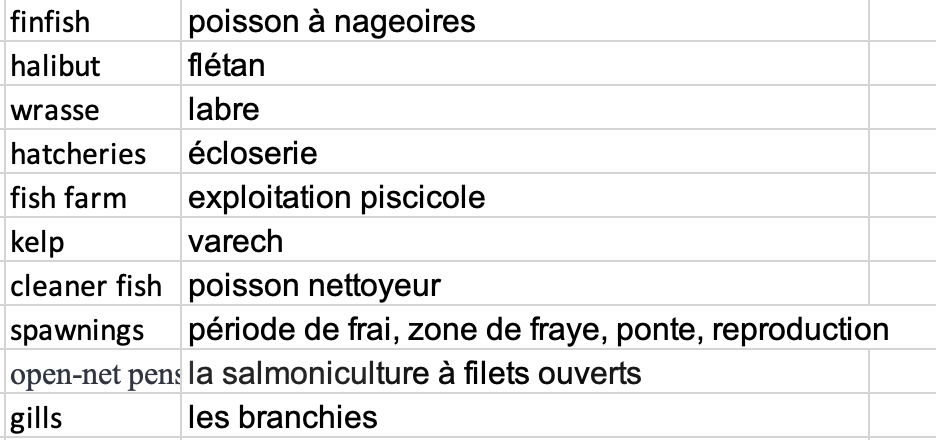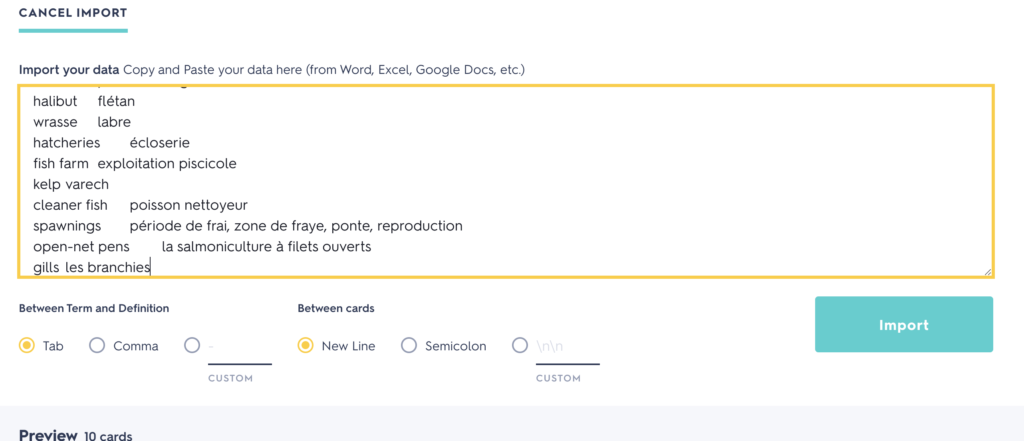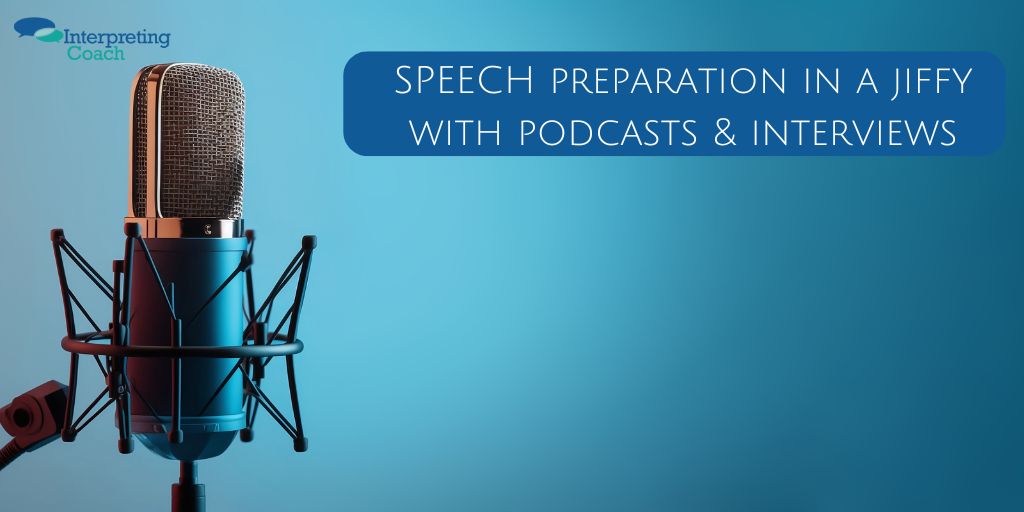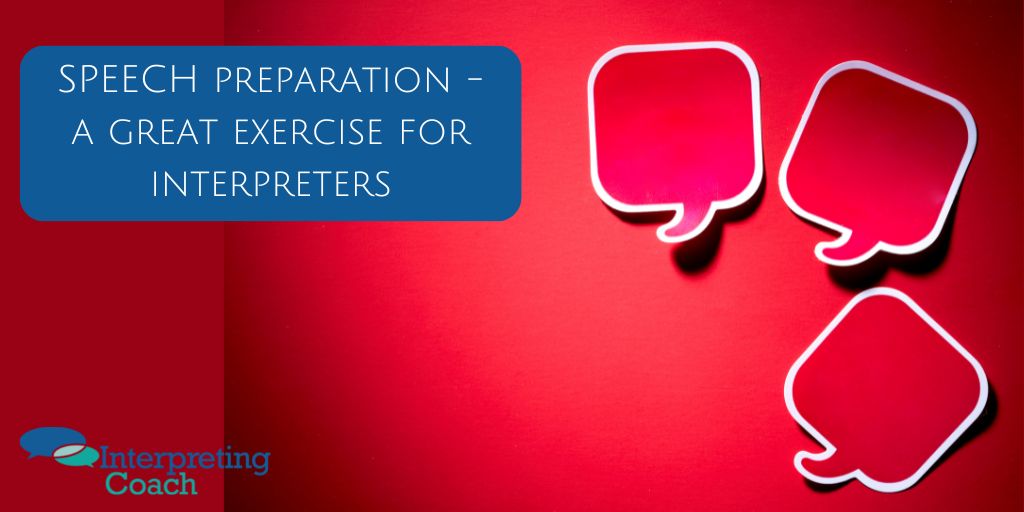I’ve written quite a lot about speech preparation as a useful exercise, both for interpreters and for trainers.
In this post, for example, I’ve talked about the benefits of speech prep, and in this one, I’ve outlined how I go about preparing a speech quickly and efficiently.
Today, I want to talk about how you can create an outline for three different types of speech very quickly – i.e., how to extract the maximum amount of juice from your hard work! If you’re a trainer, for instance, you don’t want to spend 2 hours on a single speech. The process I will describe will allow you prepare three speeches in one fell swoop – or even more!
The idea is to use the same research and background knowledge to create a simultaneous, a consecutive with notes, and a consecutive without notes on the same subject. But read on, and you’ll see that you can take things even further and prepare several short speeches on different subjects, or approach a subject from different angles.
Step 1: create an outline for a consecutive speech
For more detail on how to pick a suitable subject and research it, refer to my previous post.
In brief, I chose bedbugs as my topic, because I heard a piece about the recent outbreak on a Radio 4 programme called ‘PM’, and the very next day, an interpreting colleague mentioned she had been evacuated from a Paris-Strasbourg train because of bedbugs.
I spent 10 minutes or so reading this article in The Guardian, and this one in the Independent, to get some ideas.
Then I came up with this outline:

I often start with an outline for a consecutive with notes, because that’s the type of speech I prepare more frequently, but you could also start with a consecutive without notes, as I’ve done here.
Consecutive without notes is by definition a short exercise without too many demands on the interpreter’s memory, i.e. few figures, dates, or names, so it’s easy to come up with an outline. You can generally only cover two or three points, subsumed under one or two main ideas, in a consecutive without notes.
Here, I’ve giv aden a personal/visual introduction, briefly explained what’s happening in France and why it’s important, then turned to whether the UK should worry, and how you can get rid of bedbugs.
With 10 minutes of research and a few minutes listening to the radio in the car, we now have an outline for a consec without notes.
How to take it further so that we can create several more speeches based on the same material?
Expanding a short speech into a longer one
On this occasion, since I had started with a consec without notes, I looked for ways to expand it into a consecutive with notes.
There are many options for introducing more challenges into a speech. You could add:
- figures
- more detail or secondary information
- someone else’s point of view
- a personal opinion
- interesting language (e.g. images, idioms)
- a quotation
- a digression
- a whole other idea or argument
On this occasion, I decided to expand the speech as follows:
- give two figures (one from Rentokil, the pest control agency, and the other referring to the number of households in France that had a bedbug infestation)
- use some more interesting descriptive language about bedbugs, and to describe Paris and London
- talk more about what political action is being taken in France; this was an opportunity to include several points of view
- give a bit of history about bedbugs, to introduce a date, and a technical term (DDT, the name of a pesticide)
- add a little more detail here and there
Expanding a consecutive into a simultaneous
When I prepare consecutive speeches, they typically last 2-5 minutes (consec without notes), 5-7 minutes (consec with notes), or 10-12 minutes (simultaneous). That’s because I work for the EU institutions and train interpreters who want to work for the EU, and the EU accreditation test uses speeches of that length.
Filling 10-12 minutes of time on a specific subject is quite different from preparing a 3 minute consec without notes. You need more facts and figures, so you can expand more on your ideas. Or you need to structure your speech so that it contains more arguments/ideas (e.g. someone else’s point of view, for instance).
Generally speaking, this requires a bit more research. On this occasion, I had everything I needed from the two articles and radio programme. All I had to do was organise the material in a way that suited me; I added whole extra sections (“has there really been an increase in the number of bedbugs?” and “what risk do they pose?”), as well as changing the conclusion.
I’ve put my three speech outlines in a table, so you can compare them and see how I’ve added information to turn the original short speech into a longer consec with notes and then a simultaneous.
In the first column (my original outline for a consec without notes), I’ve put the links between ideas in bold.
In the second and third columns, I’ve put extra information in bold.
| CONSEC WITHOUT NOTES | CONSEC WITH NOTES | SIMULTANEOUS |
| Intro: colleague travelling by train from Paris to Strasbourg is evacuated bcs of bedbugs | Intro: colleague travelling by train from Paris to Strasbourg is evacuated bcs of bedbugs | Intro: colleague travelling by train from Paris to Strasbourg is evacuated bcs of bedbugs |
| We used to encounter bedbugs in dodgy hostels when backpacking around the world; now they’re everywhere in Paris | We used to encounter bedbugs in budget hostels when backpacking around the world during gap year – red bites on arms and legs; now they’re everywhere in Paris/France | We used to encounter bedbugs in budget hostels when backpacking around the world during gap year – red bites on arms and legs; now they’re everywhere in Paris/France |
| Or at least they’re everywhere on social media! Examples: Fabric seats on trainsCinemasCharles de Gaulle airport-> widespread panic, people standing | Or at least they’re everywhere on French social media! Photos, videos of nasty little critters: – Metro – people standing – Cinemas – Charles de Gaulle airport-> widespread panic & paranoia | Or at least they’re everywhere on French social media! Photos, videos of nasty little critters: Metro – people standingCinemasCharles de Gaulle airport Figs: Anses (French national health body) says 11% households infested over past 5 years. -> widespread panic & paranoia |
| Why is this important? Bcs France is hosting the Olympic Games next year, so must be seen to be doing something | Why is this important? Bcs France is hosting the Olympic Games next year, so must be seen to be doing something (image) | Why is this important? Bcs France is hosting the Olympic Games next year, so must be seen to be doing something (image) |
| Political action: – Paris City Hall says invasion must be tackled, has written to PM & is calling for a dedicated national taskforce – Transport Minister has summoned train and bus operators to talk about how to prevent bedbugs multiplying on seats | Political action: – Paris City Hall says invasion must be tackled, has written to PM & is calling for a dedicated national task force – Transport Minister has summoned train and bus operators to talk about how to prevent bedbugs multiplying on seats | |
| History: we thought bedbugs disappeared in 1950s bcs of chemical treatments e.g. DDT, but recent resurgence. | History: we thought bedbugs (mattresses, clothes, luggage; come out at night to feed on human blood) disappeared in 1950s bcs of chemical treatments e.g. DDT, but recent resurgence. | |
| Should UK worry that bedbugs will cross the Channel (Eurostar)? Bedbugs can survive on seats & British people on hols can bring back bedbugs in suitcaseOther source: second hand furniture on resale sites e.g. Ebay and Fbook marketplace | Should people worry that bedbugs will cross the Channel from the City of Love to the Big Smoke? Yes: – Bedbug lifespan is 4-6 months, can survive for a year without eating, so could get into Eurostar seats or dirty suitcase – Other source of bedbugs in UK: second hand furniture on resale sites e.g. Ebay and Fbook marketplace | Should people worry that bedbugs will cross the Channel from the City of Love to the Big Smoke? Yes: – Bedbug lifespan is 4-6 months, can survive for a year without eating, so could get into Eurostar seats or dirty suitcase – Other source of bedbugs in UK: second hand furniture on resale sites e.g. Ebay and Fbook marketplace |
| How to protect yourself? If travelling, use luggage rack rather than putting case on bed and unpackingOnce home, put clothes through hot wash and dry at high tempSecond hand furniture: use steam cleanerIf necessary, use e.g. Rentokil to kill all bedbugs | How to protect yourself? If travelling, use luggage rack rather than putting case on bed and unpackingOnce home, put clothes through hot wash and dry at high tempSecond hand furniture: use steam cleaner If necessary, use e.g. Rentokil to kill all bedbugs | How to protect yourself? If travelling, use luggage rack rather than putting case on bed and unpackingOnce home, put clothes through hot wash and dry at high tempSecond hand furniture: use steam cleaner If necessary, use e.g. Rentokil to kill all bedbugs |
| Rentokil says there has been a 65% increase, year-on-year, in infestations | Rentokil says there has been a 65% increase, year-on-year, in infestations But this is not a good solution for low income households bcs high cost | |
| But most experts are saying it’s not the number of bedbugs that’s increasing, but number of sightings (social media). | Are there really more bedbugs in France or more sightings? Social media can make it appear that there’s a massive problem | Are there really more bedbugs in France or more sightings? Social media can make it appear that there’s a massive problem |
| Figs: Anses (French national health body) says 11% households infested over past 5 years. Is that really an increase? I’m not sure. | Is that really an increase? Experts say there’s always an increase in after July/Aug holidays. People bring them home in their luggage. But it does seem as if there is a resurgence, for several reasons: – Globalisation: container trade, tourism, immigration – Ban on DDT, so not eliminated by chemicals – Survivors are more resistant – Reduction in number of cockroaches (revolting, I think), which are bedbug predators – [BTW] for once, it’s not climate change – bedbugs are domesticated and follow humans, but global warming hasn’t changed habitat | |
| Unfortunately, that can generate panic and cause mental health problems (paranoia about bugs in mattress -> insomnia, anxiety, depression) | What IS increasing: mental health problems, e.g. insomnia, anxiety, depression. | What risk do they pose? – They don’t carry transmissible diseases – The bites don’t last. – They’re embarrassing (yuck factor) and inconvenient (cinema, travel) – I think BIGGEST RISK: mental health problems, e.g. insomnia, anxiety, depression |
| CONCLUSION: like headlice, they’re an inconvenience rather than health risk – easily dealt with though chemical resistance is more of a challenge. Experts tell us that we should target superspreaders, often ill, poor, marginalised. Whole other can of worms. |
Here’s another table about the same three speeches. Instead of writing out the whole content of the speech, I’ve highlighted the additions and stated (in bold) what kind of additional challenge this represents for the interpreter.
| CONSEC WITHOUT NOTES | CONSEC WITH NOTES – additions & type of challenge | SIMULTANEOUS |
| Intro: colleague travelling by train from Paris to Strasbourg is evacuated bcs of bedbugs | ||
| We used to encounter bedbugs in dodgy hostels when backpacking around the world; now they’re everywhere in Paris | red bites on arms and legs > secondary information | |
| Or at least they’re everywhere on social media! Examples: Fabric seats on trainsCinemasCharles de Gaulle airport-> widespread panic, people standing | Photos, videos > secondary information of nasty little critters > use of language | |
| Why is this important? Bcs France is hosting the Olympic Games next year, so must be seen to be doing something | ||
| Political action: – Paris City Hall says invasion must be tackled, has written to PM & is calling for a dedicated national taskforce – Transport Minister has summoned train and bus operators to talk about how to prevent bedbugs multiplying on seats Different viewpoints | ||
| History: we thought bedbugs disappeared in 1950s bcs of chemical treatments > date e.g. DDT, but recent resurgence. > technical detail (subject knowledge) | (mattresses, clothes, luggage; come out at night to feed on human blood) > secondary information/lists | |
| Should UK worry that bedbugs will cross the Channel (Eurostar)? Bedbugs can survive on seats & British people on hols can bring back bedbugs in suitcaseOther source: second hand furniture on resale sites e.g. Ebay and Fbook marketplace | the City of Love, the Big Smoke > use of language, imagery Bedbug lifespan is 4-6 months, can survive for a year without eating > numbers | |
| How to protect yourself? If travelling, use luggage rack rather than putting case on bed and unpackingOnce home, put clothes through hot wash and dry at high tempSecond hand furniture: use steam cleanerIf necessary, use e.g. Rentokil to kill all bedbugs | ||
| Rentokil says there has been a 65% increase, year-on-year, in infestations >figure | But this is not a good solution for low income households bcs high cost > Extra argument | |
| But most experts are saying it’s not the number of bedbugs that’s increasing, but number of sightings (social media). | ||
| Figs: Anses (French national health body) says 11% households infested over past 5 years. > figure Is that really an increase? I’m not sure. > personal opinion | Is that really an increase? Experts say there’s always an increase in after July/Aug holidays. People bring them home in their luggage. But it does seem as if there is a resurgence, for several reasons: Globalisation: container trade, tourism, immigration Ban on DDT, so not eliminated by chemicals Survivors are more resistant Reduction in number of cockroaches (revolting, I think), which are bedbug predators [BTW] for once, it’s not climate change – bedbugs are domesticated and follow humans, but global warming hasn’t changed habitat > extra arguments/list | |
| Unfortunately, that can generate panic and cause mental health problems (paranoia about bugs in mattress -> insomnia, anxiety, depression) | What risk do they pose? >whole extra section/argument They don’t carry transmissible diseases The bites don’t last They’re embarrassing (yuck factor) and inconvenient (cinema, travel)extra argument I think BIGGEST RISK: mental health problems, e.g. insomnia, anxiety, depression > personal opinion | |
| CONCLUSION: like headlice, they’re an inconvenience rather than health risk – easily dealt with though chemical resistance is more of a challenge. Experts tell us that we should target superspreaders, often ill, poor, marginalised. > New argument Whole other can of worms. > Idiom/pun |
I hope I’ve illustrated clearly how easy it can be to take two or three sources of information (podcasts, newspaper articles), and turn them into three different speeches in a relatively short space of time.
You can tailor the speech to your students’ or practice partners’ needs, by choosing different challenges to add (e.g. figures, lists, points of view, etc.)
Taking it even further
You could, of course, go even further than this.
The simultaneous outline I’ve created gives me scope for preparing several more speeches in similar, or even quite different, topics.
The easiest type of speech to produce would be consec without notes, since it hardly requires any more research. You can draw on background knowledge to expand the ideas or take them in new directions.
Here are some ways I could repurpose the underlying material in my simultaneous speech to produce several more consec without notes speeches:
A speech about what countries do in the run-up to the Olympics
- Intro: bedbug problem in France is making headlines. Why? Olympics
- > City Hall and Macron’s government are suggesting action (bcs of their image)
- Other countries have done similar things in the run-up to Olympics, e.g. Athens rounding up stray dogs and getting homeless people off the streets
- This is like only tidying your house when people are coming round for dinner! Better to do little and often,
- Concl: countries should have appropriate policies that are not just predicated on public image
A speech about whether there has really been a resurgence of bedbugs
- Intro: current bedbug problem in France. Is this really an increase in numbers?
- No: there is always an increase after the summer holidays. This is just a normal cycle, but we’re talking more about it bcs of social media
- Yes: globalisation; ban on DDT; resistant bugs; fewer cockroaches > there are, in fact, more bedbugs
- Concl: take precautions
A speech about how social media can create panic
- Intro: bedbug problem in France
- use of social media causes panic > mental health problems
- similar examples: COVID vaccine
- Concl: social media can be beneficial (e.g. sharing useful info) but also exacerbate the problem
One of these speeches is about bedbugs, but the other two use the bedbug example to illustrate a different point. It only took a few moments of brainstorming to create an outline for the speeches.
Conclusion
I imagine this post will be most useful to interpreter trainers. I hope I’ve shown clearly how you can extract the maximum possible benefit from the time and effort you spend in writing speeches for your students.
With a simple starting point and 15 minutes or so of research, you could create an outline for a simultaneous, a consec with notes, and 4 different consec without notes in the space of an hour or so.
What are your top tips for being efficient when preparing speeches for interpreting students?

